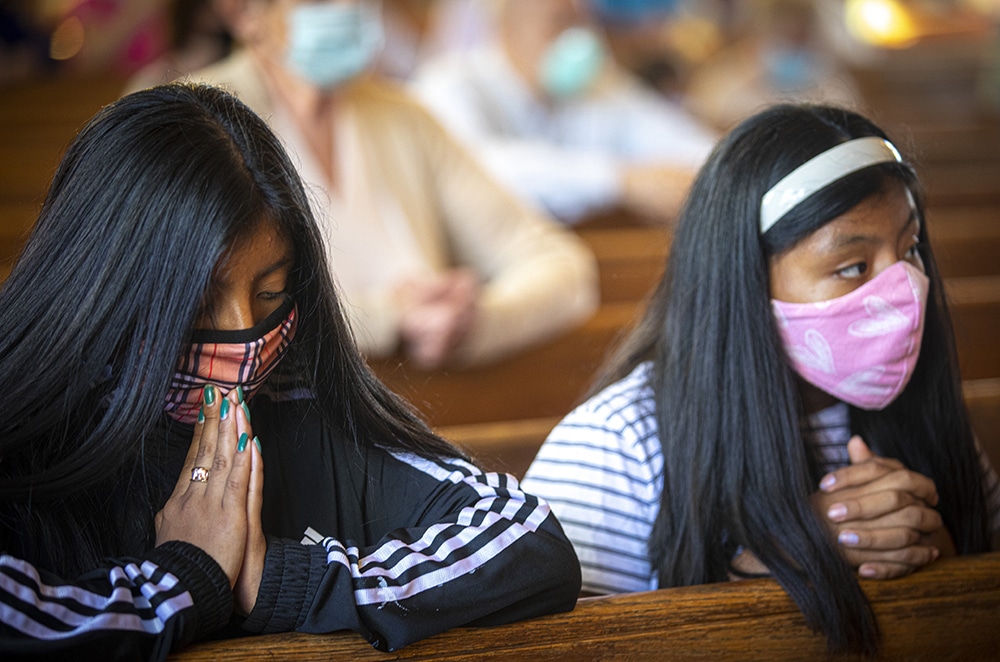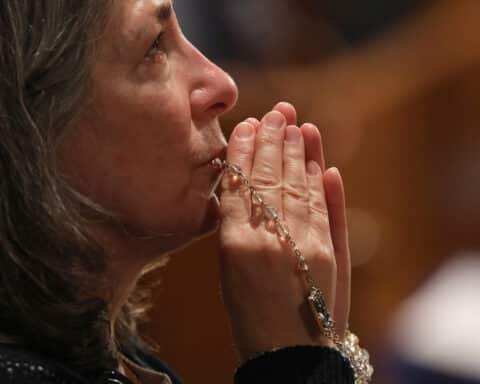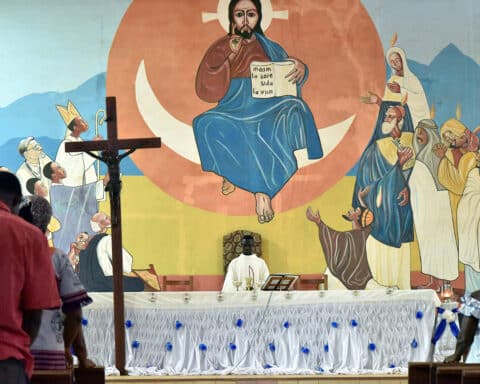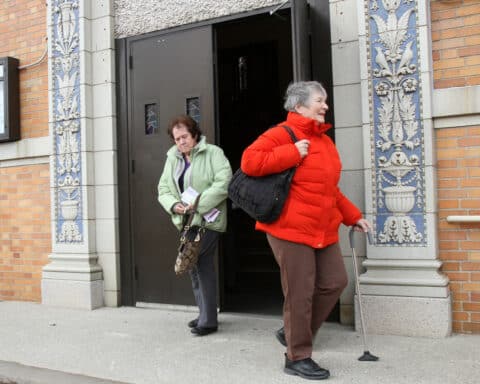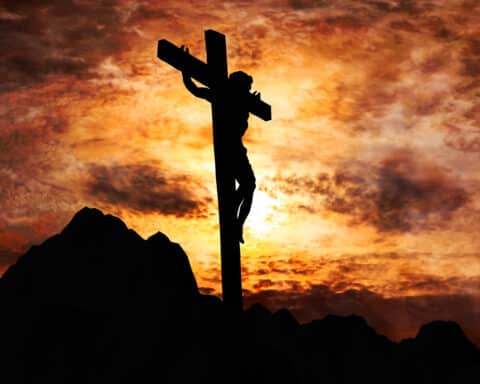Nearly six months have passed since most American parishes have reopened and Catholics have returned to mass after pandemic-related closures. What have we learned about the safety of attending Mass and other parish-related functions? How is the situation different now in the fall of this longest of years, 2020, and what should we do in light of those differences?
Catholics believe that Mass is essential, and we have demonstrated that it can be celebrated safely, even in the midst of a respiratory virus pandemic. By following simple public health recommendations regarding masking, distancing and hand-washing, we are keeping our parishes open and providing no reason for public health or other governmental authorities to close our churches.
Consider that there are more than 17,000 parishes in the United States. If we estimate that each parish has averaged eight masses per week (five weekday masses and three weekend masses) since the last week of May, there have been well over 3 million masses celebrated in the United States. The few reports of COVID spread in churches point out attendees sitting close together without wearing masks. Some have discovered a day or two after attending Mass that they were infected with COVID-19, but no transmission occurred when masks and distancing guidelines were followed in a series of cases from the Archdiocese of Seattle. We have not seen reports of COVID super-spreading events in Catholic parishes.
| WHAT ARE CHURCHES DOING TO STAY SAFE? |
|---|
|
Despite the early fears of some, we have seen no increased risk of COVID transmission through the reception of holy Communion, and the latest guidance from the World Health Organization continues to point out that there has been no evidence of catching COVID from food.
Many parishes have placed disinfectant bottles in the pews to be used after each Mass. Multiple peer-reviewed reports in the last six months reveal that this is unnecessary unless someone infected with COVID has coughed or sneezed onto a surface within the previous hour or two. While touching contaminated surfaces is not a source of significant COVID transmission, droplets, and to a lesser extent, aerosol particles, are the main ways that COVID is spread. Larger droplets usually fall to the ground within 6 feet after breathing, coughing, singing or sneezing. However, some smaller particles (aerosols) may remain airborne for hours, and this likely explains the spread of disease when people congregate in closed spaces.
We know how to protect ourselves
Masks protect both the wearer from someone who has COVID and protects others if the wearer has COVID. An analysis of 172 observational studies and 44 comparative studies examining the use of masks for three beta-coronaviruses, SARS-CoV-2, SARS-CoV, and MERS-CoV, revealed that overall risk reduction for acquiring infection was 85% for wearing a mask; the reduction was 96% for wearing an N95 respirator, and 67% for wearing the surgical masks that are easily available at drug stores.
This same study reported that keeping a distance of at least 1 meter from infected individuals reduced risk of transmission by 82% and a 2-meter distance reduced the risk by 91%.
Another study showed there was no reduction in risk if a mask was only worn sometimes around infected individuals. And the mask must be worn over the mouth and nose. Leaving the nose exposed provides little protective benefit. Masks are not infallible; they reduce risk, but they do not eliminate risk. And another line of reasoning suggests that even if someone becomes infected while wearing a mask, that the severity of disease — and therefore likelihood of hospitalization and dying — will be less.
We have learned that following the three W’s has enabled us to maintain a life that includes most — thought not all — of our cherished activities. Wearing a mask, watching our distance and washing our hands are relatively small acts that can pay great dividends. In fact, a recent simulation suggests that 96,000 American lives can be saved between Sept. 22, 2020, and Feb. 28, 2021, if 85% of Americans wear masks in public, and 130,000 saved if 95% wear masks. Current mask adherence in the United States is about 50% up from 20% in April.
We have also learned that the highest risk factors to avoid are the three C’s: closed spaces, crowded places and close-contact settings. Widespread public adherence to avoiding the three C’s has been credited with ending the pandemic in Japan.
The situation different now
In the spring, we Americans “flattened the curve” so that hospitals were not overwhelmed. Physicians and nurses volunteered and traveled to New York City and other hot spots to assist. Now, in the fall, with the onset of colder weather and more indoor activities, hospitals are being overwhelmed, and hospitals are finding it difficult to find available physicians to travel.
The peak daily COVID case-count was about 36,000 in the spring (April 25) and 76,000 in the summer (July 17). On November 12, over 160,000 new cases were found, and the seven-day average was increasing steeply. Due to the extensive presence of COVID cases in our communities, we are more likely now to contract COVID than we were in the spring or summer.
Hospitals in some areas have reached capacity as hospitalizations nationwide have flown by the peak number of COVID hospitalizations of nearly 60,000 seen both in the spring (April 15) and summer (July 23). On Nov. 12, that number had quickly risen to more than 67,000 people being treated for COVID-19 in hospitals. Not only are hospitals beset by record numbers of COVID patients, but colleagues tell me that they are also seeing a high number of sicker patients than average whose diseases are worse because they could not receive care and/or procedures in the spring. Some patients are being delayed in emergency rooms until there is a room available in the hospital — or until another hospital can be found for transfer. With high hospitalization rates of sicker-than-average patients, some hospitals will soon not have enough doctors and nurses to care for patients adequately, even if they have enough beds.
What should we do?
What has this got to do with Mass, church activities and family gatherings?
You may not know anyone who has suffered or died because of COVID, and all the fuss may seem unnecessary. One study revealed that personal experience makes a profound difference as to how likely someone is to adopt preventive measures in an epidemic.
I have experienced both the direct and indirect harms of COVID. Directly, I know someone whose family member under age 60 died of COVID and another whose children’s bus driver died of COVID. Families of friends have suffered through the illness. Two of my children had to disrupt their jobs because of quarantine after exposure to a COVID patient.
Due to indirect effects of COVID, my mother-in-law died in early July. She resided in assisted living within a care facility that was not allowing visitors. In late June, she stopped eating and drinking because she couldn’t understand why she couldn’t see family and friends and go on her regular social outings. Despite the best attempts to nourish and hydrate her, she passed away. My father lives in a nursing home, and I have only been able to visit him virtually, or by standing outside a window and looking at him while we each talk on a phone.
Despite the ongoing — and worsening — pandemic, it seems that we Americans just want to be over it.
However, most people, especially Catholics, believe in certain principles. We believe first in the intrinsic, immeasurable dignity of each person. We also believe in solidarity — that your good is my good; we are in this together. We believe in the common good, that each member of society works cooperatively to attain the good of others as if it were his own. Finally, we believe in subsidiarity, that all decisions are best made at the most local level possible.
If we believe these things, we will want to reduce suffering and death due to both the direct and indirect effects of COVID. We want to keep churches open and the sacraments widely available. We want our children to benefit from schools and universities. We want to have access to medical care. We want to maintain our employment. We want less people to die of COVID. We want to keep our hospitals below capacity so that those who need in-patient care can promptly receive it from doctors and nurses who are not overwhelmed.
The means are simple. Until there is widespread immunity from immunization — and many of the vaccines in late stages of trials have been morally produced — we must rely on non-pharmaceutical interventions. If we combine masking, distancing and hand-washing when interacting with nonhousehold members indoors, we reduce our risk of contracting COVID by 98.5%.
Celebrating the holidays
Even though Christmas is coming and we want to “pack ’em in” at Church, that would be a risky proposition. Recall that community prevalence in many parts of the country is the highest it has been during the pandemic.
Therefore, to reduce risk of transmission at Mass, I believe that continuing a combination of masking, hand hygiene and distancing of nonhousehold groups will keep us safe and out of the crosshairs of authorities who might want to limit our activities. Back in May, after our first Mass back, one of my fellow parishioners asked how long I thought we would need to mask and distance at Mass. At that point, my estimate was one year; I still hold to that estimate.
What about holiday gatherings? And what if those gatherings are at home with children, or other relatives, who aren’t in your current household? Four of us physicians with children in college discussed this on a recent episode of EWTN’s “Doctor, Doctor” and decided that it would be best to give our children two options: for the 14 days prior to coming home, they will assiduously mask and distance in all their indoor activities, or when they come home, they will mask and distance indoors at home. If such behavior is not followed around the country, I predict striking increases in cases and hospitalizations — and likely deaths — following Thanksgiving and Christmas celebrations.
This isn’t advice many of us want to hear. The three W’s and the three C’s are getting old for many of us. How much risk are you willing to take, not only for yourself, but on behalf of others? I take little risk, because my average patient is over 70 years old, and I am bending over patients’ faces all day operating on them. If I infect one of them, there could be profound harm. I am also a potential link in other chains of transmission. If practicing something as simple as masking, distancing, hand hygiene and reducing my contacts with others potentially spares others suffering or death, I am glad to be able to do that. It’s a small act of charity.
As Abraham Lincoln liked to say, “This too shall pass away.” The COVID pandemic will pass away, and when it does, I want to be able to look back and know that I did my best to both protect others and foster as much normal human behavior as possible.
Thomas W. McGovern, MD, practices Mohs surgery and reconstruction in Fort Wayne, Indiana. He is a former clinical infectious disease researcher at the U.S. Army Medical Research Institute of Infectious Diseases, serves on the Thomistic Institute Working Group on Infectious Disease Protocols for Sacraments & Pastoral Care, is the co-host of “Doctor, Doctor” on the EWTN Radio Network Radio Show, and is co-author of the peer-reviewed article COVID-19 Policy-Making in a Country Divided: Catholic Social Teaching as a Path to Unity.

